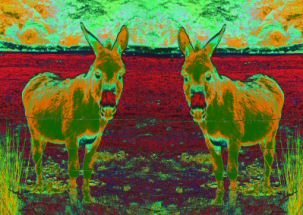Blue is higher

Red is lower
Colour Temperature is expressed in degrees Kelvin and is the temperature a black body heated to give off that colour.
The lower the temperature the 'warmer' or red the light is and the hotter the light the 'colder' or blue the light is.
The eye can distinguish a difference of 150K

Film generally comes in three types with respect to Colour Temperature.
Daylight for 5500K
Type A for 3400K
Type B for 3200K
The digital camera is either auto-matic in detecting the colour temp. and/or has a range of selections and also a manual adjustment in the more sophisticated pro-sumer and professional cameras.
In the computer with one of the better prog-grammes it is possible to correct for colour temperature or as above completely send them haywire. Above is what happens to colour when you simulate solarisation using the curves tool.
Domestic bulbs burn at between 2650K and 2980, while a candle could be around 1930K resulting in a very warm or red glow to the pictures. Flourescents are between Type A and Daylight but can have green content to upset images.
General Photographic bulbs burn at 3200K while Photofloods at 3400K and should not be mixed bearing in mind the eye can distinguish a 150K difference in light.
Mean Noon Sunlight is 5400K while blue skylight ranges between 12000K to 18000K
Electronic flash is around 5500K so is ideal for 'daylight' film which comes without any obvious labeling where as Types A&B are.
Metering for exact temperature can be done with Gossen and Minolta CT Meters but requires a stock of various correction filters to make them useful.
Kodak make a range of blue [80], bluish[82], orange[84], and yellowish[81] colour correction filters. In various strengths and require exposure adjustment of 1/3 to 2 stops
Converting Type A film to daylight is orange Wratten 85 and Type B to daylight is 85B. with 1/3 and 2/3 stop adjustment.
Working the other way requires a blue filter Wratten 80B or 80A requiring 1 2/3 and 2 stop adjustment.